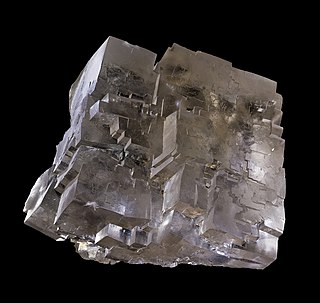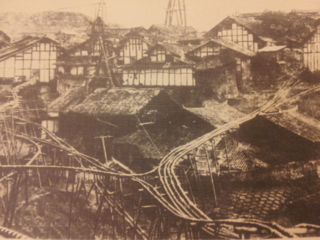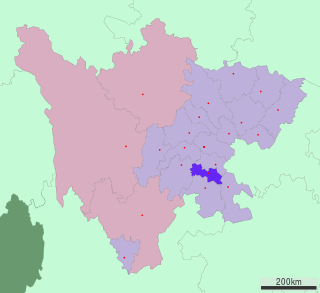
Well drilling is the process of drilling a hole in the ground for the extraction of a natural resource such as ground water, brine, natural gas, or petroleum, for the injection of a fluid from surface to a subsurface reservoir or for subsurface formations evaluation or monitoring. Drilling for the exploration of the nature of the material underground is best described as borehole drilling.

Sodium chloride, commonly known as salt, is an ionic compound with the chemical formula NaCl, representing a 1:1 ratio of sodium and chloride ions. Sodium chloride is the salt most responsible for the salinity of seawater and of the extracellular fluid of many multicellular organisms. In its edible form, salt is commonly used as a condiment and food preservative. Large quantities of sodium chloride are used in many industrial processes, and it is a major source of sodium and chlorine compounds used as feedstocks for further chemical syntheses. Another major application of sodium chloride is deicing of roadways in sub-freezing weather.

A borehole is a narrow shaft bored in the ground, either vertically or horizontally. A borehole may be constructed for many different purposes, including the extraction of water, other liquids, or gases. It may also be part of a geotechnical investigation, environmental site assessment, mineral exploration, temperature measurement, as a pilot hole for installing piers or underground utilities, for geothermal installations, or for underground storage of unwanted substances, e.g. in carbon capture and storage.

Salt mining extracts natural salt deposits from underground. The mined salt is usually in the form of halite, and extracted from evaporite formations.

A drilling rig is an integrated system that drills wells, such as oil or water wells, or holes for piling and other construction purposes, into the earth's subsurface. Drilling rigs can be massive structures housing equipment used to drill water wells, oil wells, or natural gas extraction wells, or they can be small enough to be moved manually by one person and such are called augers. Drilling rigs can sample subsurface mineral deposits, test rock, soil and groundwater physical properties, and also can be used to install sub-surface fabrications, such as underground utilities, instrumentation, tunnels or wells. Drilling rigs can be mobile equipment mounted on trucks, tracks or trailers, or more permanent land or marine-based structures. The term "rig" therefore generally refers to the complex equipment that is used to penetrate the surface of the Earth's crust.

Salt, also referred to as table salt or by its chemical formula NaCl, is an ionic compound made of sodium and chloride ions. All life depends on its chemical properties to survive. It has been used by humans for thousands of years, from food preservation to seasoning. Salt's ability to preserve food was a founding contributor to the development of civilization. It helped eliminate dependence on seasonal availability of food, and made it possible to transport food over large distances. However, salt was often difficult to obtain, so it was a highly valued trade item, and was considered a form of currency by certain people. Many salt roads, such as the via Salaria in Italy, had been established by the Bronze Age.

Zigong, formed by the merger of the two former towns of Ziliujing and Gongjing, is a prefecture-level city in Sichuan, southwestern China.

Yandusaurus is a genus of herbivorous basal neornithischian dinosaur from the Bathonian age of China.

The Zigong Salt History Museum is a museum in Zigong, Sichuan Province, Southwest China. It is housed in the Xiqin Guildhall, originally built in 1736-1752 by salt merchants from Shaanxi. This was during the reign of the Qianlong Emperor of the Qing dynasty. The building is a Major Historical and Cultural Site of China. The current museum was due to the urging of Deng Xiaoping and completed in 1959.

Open-pan salt making is a method of salt production wherein salt is extracted from brine using open pans.

In-situ leaching (ISL), also called in-situ recovery (ISR) or solution mining, is a mining process used to recover minerals such as copper and uranium through boreholes drilled into a deposit, in situ. In situ leach works by artificially dissolving minerals occurring naturally in a solid state. For recovery of material occurring naturally in solution, see: Brine mining.

A well is an excavation or structure created in the ground by digging, driving, or drilling to access liquid resources, usually water. The oldest and most common kind of well is a water well, to access groundwater in underground aquifers. The well water is drawn up by a pump, or using containers, such as buckets or large water bags that are raised mechanically or by hand. Water can also be injected back into the aquifer through the well. Wells were first constructed at least eight thousand years ago and historically vary in construction from a simple scoop in the sediment of a dry watercourse to the qanats of Iran, and the stepwells and sakiehs of India. Placing a lining in the well shaft helps create stability, and linings of wood or wickerwork date back at least as far as the Iron Age.

Ziliujing District, formerly romanized as Tzuliutsing, is a district of Zigong in Sichuan Province, China. The district covers 153 square kilometers (59 sq mi) and had a population of 330,000 people in 2005.

The Zigong dialect is a branch of Southwestern Mandarin, spoken mainly in Zigong, Fushun, Weiyuan, east Rongxian and some parts of Yibin, Neijiang, Longchang and other neighboring areas of Sichuan.

Salt, salt production, and salt taxes played key roles in Chinese history, economic development, and relations between state and society. The lure of salt profits led to technological innovation and new ways to organize capital. Debate over government salt policies brought forth conflicting attitudes toward the nature of government, private wealth, the relation between the rich and the poor, while the administration of these salt policies was a practical test of a government's competence.
Bromine production in the United States of 225,000 tonnes in 2013 made that country the second-largest producer of bromine, after Israel. The US supplied 29 percent of world production. Since 2007, all US bromine has been produced by two companies in southern Arkansas, which extract bromine from brine pumped from the Smackover Formation. At an advertised price of US$3.50 to US$3.90 per kg, the US 2013 US production would have a value of roughly US$800 million.
Brine mining is the extraction of useful materials which are naturally dissolved in brine. The brine may be seawater, other surface water, groundwater, or hyper-saline solutions from several industries. It differs from solution mining or in-situ leaching in that those methods inject water or chemicals to dissolve materials which are in a solid state; in brine mining, the materials are already dissolved.
Yanbangcai is a genre of traditional Sichuan dishes that originated in the city of Zigong in southwest China, which is famous for its salt industry.

The Salina Group or Salina Formation is a Late Silurian age unit of sedimentary rock found in North Eastern and Midwestern North America. Named for its Halite beds, the term Salina Group first know usage was by James D. Dana in 1863.

















